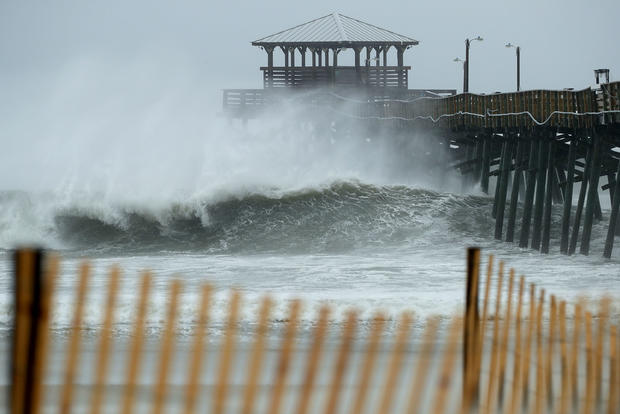'This Is A Powerful Storm That Can Kill': Hurricane Florence's Onslaught Begins
WILMINGTON, N.C. (CBS News) -- The leading edge of Hurricane Florence has arrived in North Carolina, with tropical storm-force winds carrying drenching bands of rainfall onto some beach communities, meteorologists said Thursday. The monster storm was moving in for a prolonged and potentially catastrophic stay along the Southeast coast that could drench the homes of as many as 10 million people.
Florence's top sustained wind speeds dropped from a high of 140 mph to 105 mph early Thursday, reducing Florence from a Category 4 to a Category 2 hurricane. But forecasters warned that the widening storm -- and its likelihood of lingering around the coast day after day after day -- will bring surging ocean water and torrential rain.
North Carolina Gov. Roy Cooper said he knows many people are watching the changing storm predictions and categories, and he's concerned because some are even saying that "North Carolina is getting a break."
It's not.
"Please hear my message," he said. "We cannot underestimate this storm."
"Don't relax; don't get complacent. Stay on guard. This is a powerful storm that can kill," he said.
The National Hurricane Center said Thursday afternoon that Florence's center will approach the coasts of North and South Carolina later in the day. It will move near -- or over -- the coast of southern North Carolina and northeastern South Carolina in the hurricane warning area Thursday night and Friday.
"A slow motion across portions of eastern South Carolina is forecast Friday night through Saturday night," the center said.
The storm is expected to push up to 13 feet of storm surge and dump water on both states. The forecast calls for as much as 40 inches of rain over seven days along the coast, with the deluge continuing even as the center of the storm slogs away over the Appalachian Mountains.
The result could be what the Houston area saw during Hurricane Harvey just over a year ago: catastrophic inland flooding that could swamp homes, businesses, farms and industrial sites.
An emergency management official in one of the most populated areas of coastal North Carolina said Thursday afternoon that winds from the storm have arrived and other impacts won't be far behind. New Hanover County Emergency Management Director Steven Still said residents who didn't evacuate should expect 60 mph winds by 7 p.m. that would eventually increase to 100 mph or more. He said residents "can expect to have that wind to the tune of 100 mph-plus stay on us for considerable period of time."
He said landfall is expected around 8 a.m. Friday in the Wrightsville Beach area, and that the area could see 20 to 30 inches of rain and beaches could get 9 to 10 to feet of storm surge.
Hurricane Florence fast facts:
- Hurricane Florence has started lashing North Carolina, with tropical storm-force winds carrying drenching bands of rainfall onto some beach communities
- Florence is a "large hurricane," with hurricane-force winds extending outward up to 80 miles from the center and tropical-storm-force winds extending outward up to 195 miles, National Hurricane Center (NHC) says
- Forecasters don't expect the storm to strengthen before it moves ashore, but they say the real problem will be water as it lingers along the coast through Saturday
- "It truly is really about the whole size of this storm," National Hurricane Center Director Ken Graham says. "The larger and the slower the storm is, the greater the threat and the impact -- and we have that."
- As of 2 p.m. ET, Florence was centered about 110 miles east-southeast of Wilmington, North Carolina, and about 165 miles east of Myrtle Beach, South Carolina, moving northwest at 10 mph with maximum sustained winds of 105 mph
- More than 10 million residents in North and South Carolina and Virginia are under storm watches or warnings; About 5.25 million people live in areas under hurricane warnings or watches, and 4.9 million more live in places covered by tropical storm warnings or watches, National Weather Service says
© 2018 CBS Interactive Inc. All Rights Reserved.




